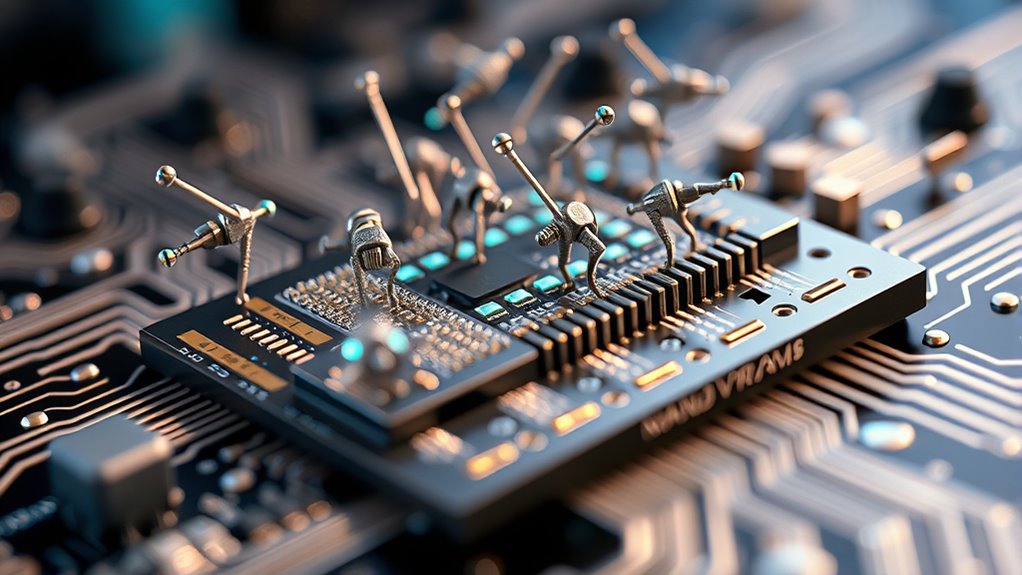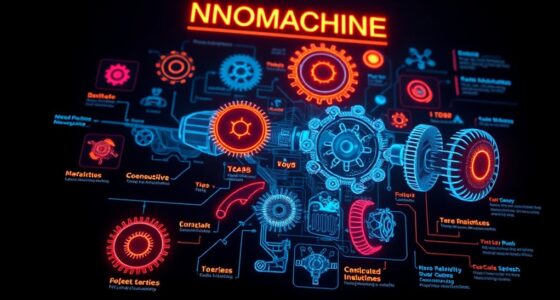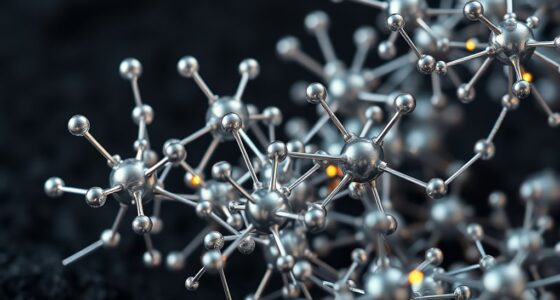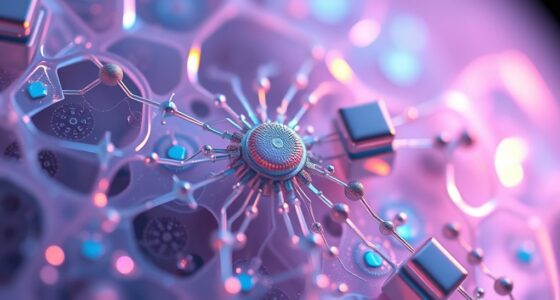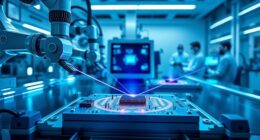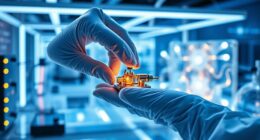Integrating nanomachines into microchips is opening new paths for hybrid devices with advanced capabilities. Thanks to recent breakthroughs, you can now see improvements in precise assembly, molecular engineering, and quantum control techniques, making complex, reliable structures possible. These innovations lead to smarter sensors, faster electronics, and innovative medical tools. While challenges like material compatibility and placement remain, ongoing research promises exciting future developments. Keep exploring to uncover how these technologies reshape industry and society.
Key Takeaways
- Advances in nanomachine fabrication enable precise placement and integration within microchips for hybrid device development.
- Techniques like atomic force microscopy and self-assembly facilitate nanoscale alignment and autonomous organization.
- Material compatibility challenges require innovative engineering to ensure stability and functionality of hybrid nanomachine-microchip systems.
- Integration enhances device capabilities, enabling applications in healthcare, environmental monitoring, and smarter electronics.
- Future progress depends on improving placement accuracy, managing power, and addressing ethical and societal implications.
Advances in Nanomachine Technology and Fabrication

Recent breakthroughs in nanomachine technology have markedly advanced the fabrication process, enabling more precise control at the atomic and molecular levels. Molecular engineering plays a vital role, allowing you to design and manipulate individual molecules with high accuracy. This progress is complemented by advancements in quantum control, which help you regulate the behavior of nanomachines at the quantum level. These techniques enable you to assemble complex nanostructures reliably, improving their functionality and stability. Additionally, home decoration inspiration can influence how nanomachines are integrated into consumer devices, enhancing both aesthetics and performance. As a result, you can now create nanomachines with tailored properties suitable for integration into microchips. The combination of molecular engineering and quantum control pushes the boundaries of what’s possible, leading to more efficient, scalable, and precise fabrication methods for next-generation nanodevices.
Methods for Embedding Nanomachines Into Microchips

You can embed nanomachines into microchips using several approaches, each offering unique advantages. Direct nano-assembly involves positioning components precisely, while layered fabrication builds structures layer by layer. Self-assembly strategies enable nanomachines to organize themselves within the chip, streamlining integration.
Direct Nano-Assembly Techniques
Direct nano-assembly techniques involve precisely positioning and integrating nanomachines within microchips through controlled, bottom-up processes. You focus on nanoscale alignment to guarantee each nanomachine is accurately placed, maintaining functional connectivity. Molecular wiring plays a critical role, enabling electrical and signal connections at the atomic level, which is essential for device performance. These methods often employ techniques like atomic force microscopy, electron-beam lithography, or chemical self-assembly to achieve exact positioning. You can manipulate individual nanomachines, ensuring they are correctly oriented and connected within the microchip’s architecture. This approach minimizes errors and maximizes integration efficiency. By leveraging these precise techniques, you set the foundation for creating hybrid devices that combine the unique functionalities of nanomachines with traditional microchip components.
Layered Fabrication Methods
Layered fabrication methods offer a systematic approach to embedding nanomachines within microchips by building up multiple, precisely controlled layers. This technique ensures strong layer adhesion, which is essential for device durability and performance. By carefully optimizing each layer’s deposition process, you can achieve consistent integration of nanomachines without compromising their functionality. Additionally, layered fabrication supports fabrication scalability, allowing you to produce complex, multi-layered devices efficiently. This approach provides flexibility in designing hybrid microchips, enabling you to incorporate diverse nanomachine functionalities within the same structure. As you refine the layering process, focus on maintaining adhesion strength and process repeatability, which are critical for reliable, large-scale manufacturing of integrated nano-micro hybrid devices.
Self-Assembly Strategies
Building on layered fabrication methods, self-assembly strategies offer an alternative approach that leverages the inherent properties of nanomachines to form organized structures within microchips. By applying molecular patterning techniques, you can guide nanomachines to assemble precisely where needed. These methods utilize self-organization principles, allowing nanomachines to autonomously arrange themselves into functional configurations without extensive external manipulation. This process reduces manufacturing complexity and enhances scalability, as nanomachines naturally seek energetically favorable states. You can design specific surface chemistries or templates to direct self-assembly, creating reliable, reproducible arrangements within the chip. Overall, self-assembly strategies enable efficient integration of nanomachines, harnessing their intrinsic tendencies for organized formation and opening pathways for innovative hybrid device architectures.
Potential Applications of Hybrid Nanomachine-Microchip Devices
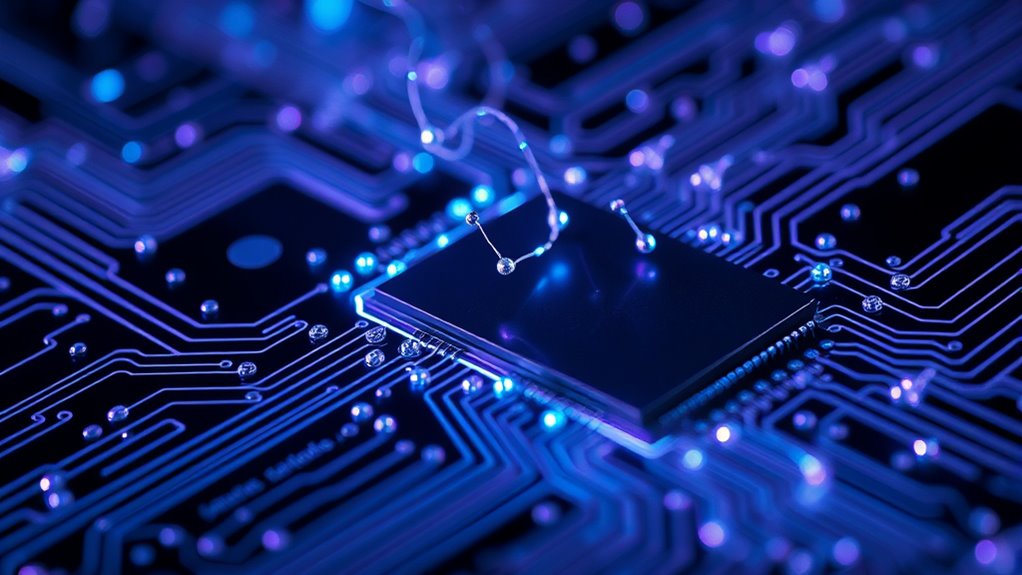
Hybrid nanachine-microchip devices hold the potential to revolutionize various fields by enabling unprecedented levels of control and functionality at the microscopic scale. You could use them for advanced medical diagnostics, allowing real-time detection of biomarkers with high sensitivity and speed. They also open new avenues in environmental monitoring, detecting pollutants or toxins at trace levels. These devices can perform complex tasks autonomously, improving accuracy and response times. To illustrate, consider the table below:
| Application Area | Key Benefits | Example Tasks |
|---|---|---|
| Medical Diagnostics | Fast, precise disease detection | Blood analysis, biomarker sensing |
| Environmental Monitoring | Real-time pollutant detection | Water quality assessment |
| Drug Delivery | Targeted therapy | Precision medication release |
| Bioinformatics | Data collection and analysis | Pathogen identification |
| Industrial Safety | Hazard detection | Toxic gas monitoring |
Furthermore, advancements in nanotechnology integration are crucial for optimizing the performance and miniaturization of these hybrid devices.
Challenges and Limitations in Integration Processes
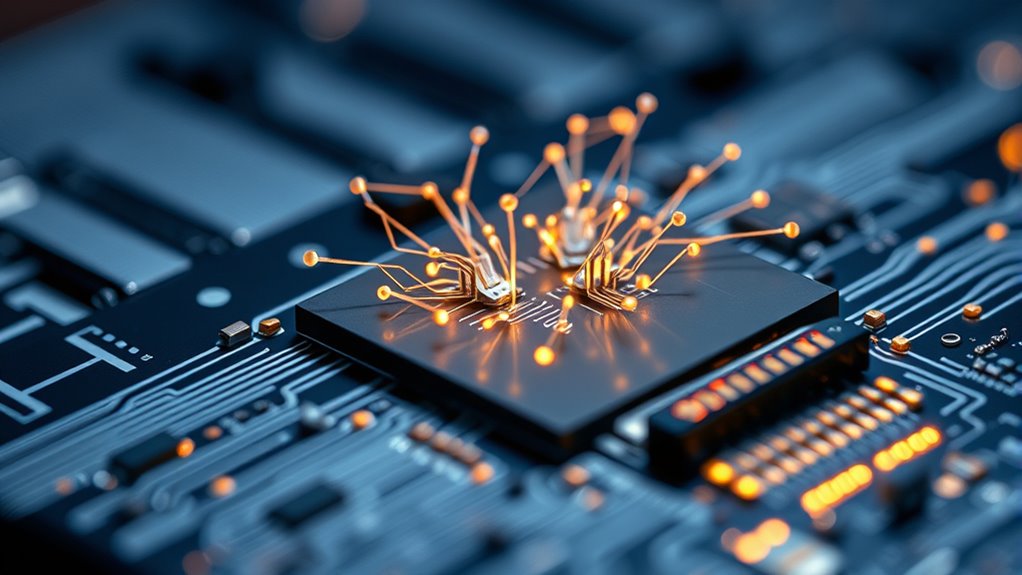
You’ll find that precisely placing nanomachines on microchips is a major challenge, often requiring advanced techniques to guarantee accuracy. Material compatibility also poses difficulties, as some nanomaterials may not integrate well with existing chip components. Overcoming these hurdles is essential for reliable and scalable nanomachine integration. Additionally, insights from AI-powered design tools can assist in optimizing integration processes and addressing complex material interactions.
Precise Nanomachine Placement
Achieving precise placement of nanomachines within microchips presents significant challenges that hinder seamless integration. Molecular docking techniques are essential to guarantee nanomachines attach accurately, but controlling this process at the nanoscale remains difficult. Nanoscale alignment demands exact positioning, which is complicated by thermal fluctuations, surface irregularities, and limitations of current manipulation methods. You must overcome these hurdles to ensure nanomachines are correctly oriented and anchored without damaging delicate structures. Precise placement is critical for ideal functionality and device performance, yet existing technologies often lack the resolution and reliability needed for consistent results. As a result, achieving accurate, reproducible placement continues to be a major obstacle in developing fully integrated hybrid devices.
Material Compatibility Challenges
Once nanomachines are precisely positioned within microchips, integrating different materials becomes a significant obstacle. Material compatibility challenges include biocompatibility concerns, which raise issues about how nanomachines interact with surrounding components. Thermal expansion issues can cause mechanical stress, leading to delamination or failure. You also face difficulties aligning materials with different electrical properties, risking signal loss or interference. Compatibility of fabrication processes may require high temperatures incompatible with nanomachine stability. Additionally, chemical incompatibilities might cause corrosion or degradation over time. These issues demand careful material selection and innovative engineering solutions to ensure durability, functionality, and safe operation. Overcoming such challenges is essential for developing reliable hybrid devices capable of integrating nanomachines seamlessly into microchips.
Future Perspectives and Emerging Trends
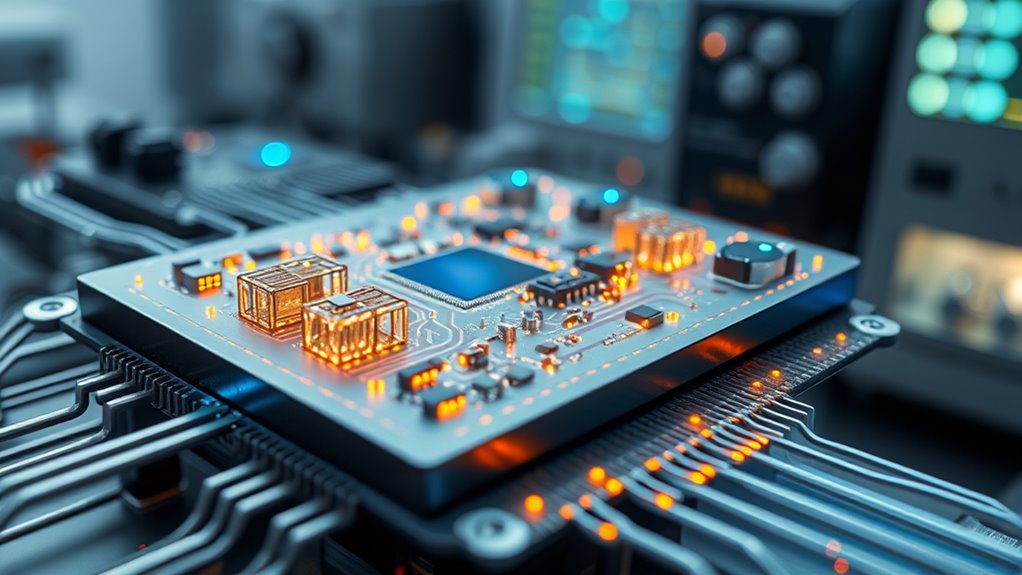
As nanotechnology continues to advance, integrating nanomachines into microchips is poised to revolutionize computing and electronics. Future trends focus on overcoming biocompatibility concerns, ensuring nanomachines can operate safely within biological environments without adverse effects. You’ll see increased emphasis on developing environmentally friendly and sustainable materials to address ethical considerations and minimize ecological impact. Emerging techniques aim to enhance the precision and scalability of nanomachine integration, paving the way for smarter, more efficient hybrid devices. Researchers are also exploring adaptive systems that can respond dynamically to external stimuli, opening new applications in healthcare, data storage, and sensory technologies. Additionally, understanding battery-less inverters can inspire innovative power solutions for future hybrid systems. By addressing these challenges head-on, you’ll be at the forefront of a transformative era where nanomachines seamlessly blend with microchip technology, unleash unprecedented potential.
Impact on Industries and Technological Innovation
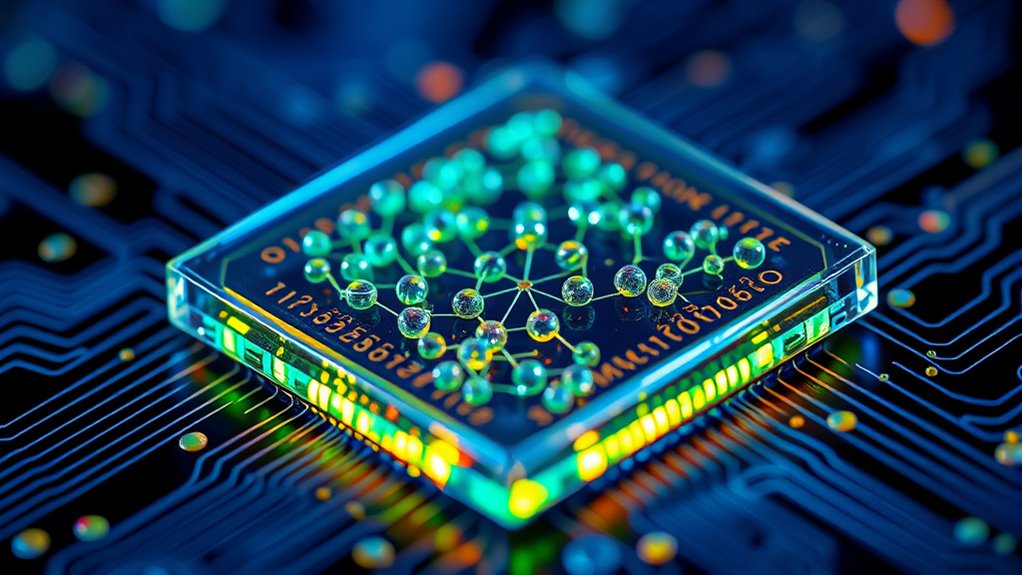
Integrating nanomachines into microchips is set to transform industries by enabling faster, more efficient, and highly miniaturized devices. This leap will accelerate innovation across sectors like healthcare, electronics, and energy. You’ll see smarter sensors, powerful AI processors, and enhanced data storage. However, these advancements raise ethical considerations around privacy, security, and environmental impact. Regulatory frameworks will need to evolve to address potential risks and guarantee safe deployment. Industries must adapt to these changes, investing in new research and infrastructure. The integration promises breakthroughs that could redefine manufacturing, communication, and diagnostics. Additionally, cybersecurity measures will become increasingly crucial to protect these advanced systems from malicious threats. Still, balancing innovation with responsible oversight remains vital to avoid misuse and unintended consequences, ensuring this technological revolution benefits society as a whole.
Frequently Asked Questions
How Do Nanomachines Communicate Within Microchips?
You can think of nanomachines communicating within microchips through quantum signaling and molecular communication. Quantum signaling uses quantum states to transmit information securely and efficiently, while molecular communication relies on molecules moving between nanomachines to send messages. You’ll see these methods enable precise, rapid interactions at the nanoscale, allowing nanomachines to coordinate functions seamlessly within the microchip, ultimately creating more advanced and integrated hybrid devices.
What Are the Safety Concerns of Integrating Nanomachines?
You should consider safety concerns like biocompatibility and environmental impact when integrating nanomachines. These tiny workers might spark unforeseen reactions, risking toxicity or immune responses, like sparks flying in a delicate dance. Environmental hazards could ripple outward, contaminating ecosystems. Ensuring safe materials and containment measures is essential, so your innovation doesn’t turn into an uncontrolled wildfire. Protecting both human health and the planet keeps your nanotech journey on a responsible path.
Can Existing Microchip Manufacturing Methods Accommodate Nanomachines?
Existing microchip manufacturing methods face significant scalability challenges when it comes to accommodating nanomachines. You’ll find that integrating nanomachines requires new manufacturing techniques and precise manufacturing integration, which current processes aren’t fully equipped for. This means you need to innovate and adapt your methods to handle the tiny scale effectively, ensuring consistent quality, alignment, and functionality across large production volumes. Overcoming these challenges is key to advancing hybrid device technology.
What Is the Cost Impact of Developing Hybrid Devices?
The cost of developing hybrid devices is like planting a seed in fertile ground—you’ll need to nurture it with careful cost analysis and budget considerations. While initial expenses may soar due to advanced nanomachine integration, long-term benefits like enhanced performance and innovation can outweigh these costs. You must weigh the investment against potential gains, understanding that pushing technological boundaries often demands a higher upfront price but promises future rewards.
How Do Nano-Robotics Ethics Influence Device Development?
You should consider ethical considerations and societal impacts when developing nano-robotics devices. These ethics guide responsible innovation, ensuring you address privacy, safety, and potential misuse. By prioritizing transparency and public engagement, you help build trust and prevent harm. Balancing technological advancement with ethical standards guarantees your work benefits society while minimizing risks, ultimately fostering sustainable and acceptable nano-robotic innovations.
Conclusion
As you envision these hybrid devices taking shape, picture tiny nanomachines seamlessly woven into microchips like stars aligning in a night sky. This fusion ignites a new era of innovation, where your creations become smarter, faster, and more adaptable. While challenges remain, the path ahead shines brightly with promise, guiding you toward breakthroughs that will transform industries. Embrace this journey, and watch as these miniature marvels propel technology into a dazzling future.
